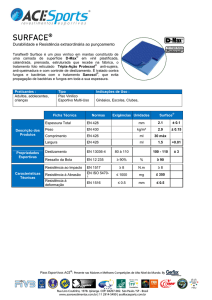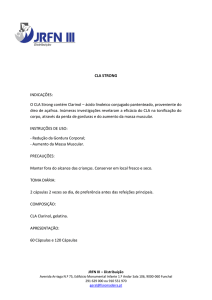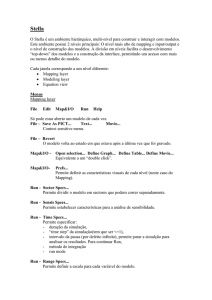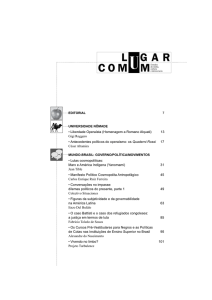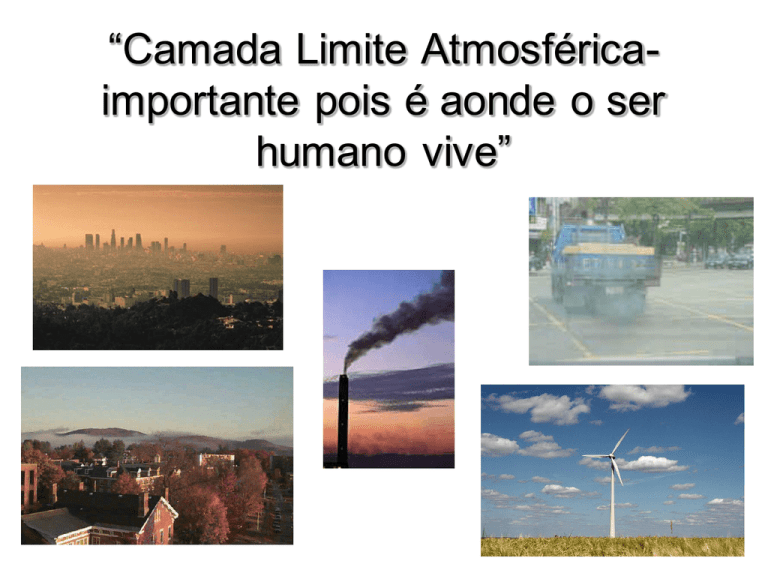
“Camada Limite Atmosféricaimportante pois é aonde o ser
humano vive”
An Example of the Effects of Haze
in the Mid-Atlantic
The Great Smoky Mountains National Park
A Clear Day
Photos from www.epa.gov
A Hazy Day
Definição da Camada
Limite Planetária
• A CLP é definida pela presença
de mistura turbulenta entre a
superfície terrestre o ar em uma
escala de tempo inferior a
algumas horas
Turbulence inside the boundary layer
Definition of Turbulence:
The apparent chaotic
nature of many flows,
which is manifested in
the form of irregular,
almost random
fluctuations in velocity,
temperature and scalar
concentrations around
their mean values in
time and space.
História da Micrometeorologia
• Meteorologia: Aristóteles (322 AC) – elementos
do clima (ar, água, fogo, solo)
• Meteorologia: ciência da atmosfera (física da
atmosfera), incluindo previsão do tempo
• Micrometeorologia: fundamentos originários da
hidrodinâmica (Reynolds, 1894, Taylor, 1915,
Prandtl, 1925, Richardson, 1920, Schmidt,
1925). Micrometeorologia moderna (conceito de
turbulência: anos 40 Russia), desenvolvimento
da instrumentação (eddy-correlation technique)
no anos 50, experimentos de campo e Teoria de
Monin-Obhukov (1954).
Micrometeorologia (1/2)
• Movimentos atmosféricos possuem uma
variedade de escalas (temporal e espacial):
• Espacial: de mm até milhares km
• Temporal: de s até meses/anos
• (denominações: local, regional, global)
• Micro: ramo da ciência Meteorológica que
estuda/analisa/investiga os fenômenos
atmosféricos, caracterizados por
microescala (pequena ou local)
Arya, 2002
Fisch, 2009
2
Height (km)
Free Atmosphere
1
Mixed
Layer
Residual Layer
Mixed
Layer
Low Level Jet
Stable Nocturnal Boundary Layer
0
surface layer
afternoon
surface layer
sunset
midnight
sunrise
surface layer
noon
Vertical structure of the boundary layer
From bottom up:
• Interfacial layer (0-1 cm): molecular transport, no turbulence
• Surface layer (0-100 m): strong gradient, very vigorous turbulence
• Mixed layer (100 m - 1 km): well-mixed, vigorous turbulence
• Entrainment layer: inversion, intermittent turbulence
Escalas do Movimento Atmosférico
1/2/2012
Oke (1987)
Lecture 01 - Introduction
16
Van der Hoven (1957)
Harrris (JWIA, 2008)
Micrometeorologia (2/2)
• Ocorrem na parte baixa da troposfera
(denominada de Camada Limite Atmosférica –
CLA ou Camada Limite Planetária (CLP), no
qual a superfície e a atmosfera interagem.
• Estuda as trocas gasosas de calor/energia,
momentum, massa, ocorrendo continuamente
entre a superfície e a atmosfera
• Exemplos: Balanços de radiação e de energia,
perfis verticais das propriedades, estatística dos
processos turbulentos, atrito/cisalhamento do
vento, processos convectivos, etc.
Camada Limite Atmosférica:
conceito e características
• CL é definida como sendo uma camada
de fluído (água ou ar) próxima a uma
superfície, onde ocorre uma significativa
troca de momentum, calor/energia e
massa. Variações bruscas das
propriedades do escoamento
(velocidade,temperatura, umidade)
ocorrem (Conceito de Engenharia)
CLA: características
• A CLA é formada como consequência da interação entre
a superfície (água/terra/biosfera) e a atmosfera, com
escala de tempo de algumas horas até 1 dia. Nesta
região ocorre o mecanismo de transferência turbulenta
vertical (ou mistura). A espessura (ou altura) da CLA
(sobre o continente) pode variar entre alguma centenas
de metros até poucos km e depende do fluxo de calor da
superfície (e do entramento), do cisalhamento do vento,
caracteristicas da superficie – rugosidade, topografia,
movimento vertical de larga-escala, advecção horizontal.
Esta variação (altura) depende das condições de
umidade do solo (que determina o fluxo de calor
sensível). Em superfície plana e homogenea, a CLA é
considerada como sendo horizontalmente homogenea
Turbulência
• Movimento caótico (transporte vertical eficiente). A CLA
pode ser considerada a região onde a turbulência é
importante ao passo que a atmosfera livre possui um
movimento mais laminar (portanto, topo da CLA pode
ser interpretado também como o nível que a turbulência
desaparece ou torna-se insignificante).
• Movimentos turbulentos são representações de forma
aleatória e irregular da velocidade, temperatura,
concentração. Análise é feita por estatística (valores
médios, desvios, momentos superiores) nas escalas de
tempo e espaço.
Turbulence
• Irregular, almost random 3D velocity
fluctuations in a fluid
• Physical manifestations visible by tracers
–
–
–
–
–
–
–
swirls of leaves
swaying grass
ripples on water surface
irregular motions of kites
spreading of smoke
confetti
etc.
• Gustiness is a simple indicator of
turbulence
– e.g. standard deviation of wind / mean wind
1/2/2012
Lecture 01 - Introduction
22
Camada Limite Superficial
• CLS: é a parte mais baixa da CLA (1/10
de altura ou aproximadamente 100-150 m)
onde o efeito da rotação da Terra (efeito
Coriolis) pode ser desprezado. Não possui
uma variação clara (como o topo da CLA)
e é nesta região que o ocorrem as trocas
mais intensas. A influência dos elementos
de rugosidade é muito importante
(Validade da Teoria de Monin-Obhukov)
The „Surface Layer‟
• Physical properties
– Layer dominated by mechanically-induced turbulence,
i.e. forced convection caused by surface friction
– Large vertical gradients in meteorological variables
• Coriolis effect small, usually ignored
• „Top‟ of this layer not well defined
– More accurate is to think of a transition zone between
surface and mixed layers.
• Occupies ~lowest 10 th of the PBL, i.e. 0.1h
– However, is nonexistent without wind!
1/2/2012
Lecture 01 - Introduction
24
Boundary layer over land:
Comparison between day and night
Strongly stable lapse rate
Nearly
adiabatic
Super-adiabatic
Kaimal and Finnigan 1994
Weakly stable lapse rate
Nearly
adiabatic
Strongly stable lapse rate
•
Subtle difference between convective mixed layer and residual layer:
Turbulence is more vigorous in the former
Diurnal evolution of the convective and stable boundary layers in
response to surface heating (sunlight) and cooling.
Representação dos vórtices dentro da CLP
Convection and Advection
• Convection - the circulatory motion that
occurs in a fluid at a non-uniform
temperature owing to the variation of its
density and the action of gravity, usually
referring to vertical motions.
– Hot cells are transported within cooler
surroundings
• Advection – horizontal transport in the
atmosphere, including heat and mass!
1/2/2012
Lecture 01 - Introduction
29
Free Convection
1/2/2012
Lecture 01 - Introduction
30
Free + Forced Convection
1/2/2012
Lecture 01 - Introduction
31
„Organized‟ Convection
1/2/2012
Lecture 01 - Introduction
32
PBL Continued
• Thickness
– varies from < 100 m – a few km
– Diurnal (daily) variations
• Thickening by daytime surface heating, cold air advection
over warm surface, increased macro-scale flow
• Thinning at night due to radiative surface cooling
• PBL top also fluctuates spatially from convection cells
– Depends on surface heating rate, strength of winds,
surface roughness elements, etc.
• Nighttime PBL top difficult to define
1/2/2012
Lecture 01 - Introduction
33
The „Mixed‟ Layer
• Physical Properties
– Characterized more by
buoyant instability, i.e.
free convection than by
forced convection (wind
shear)
– Diurnal variations in
meteorological variables
smaller than in surface
layer.
– Ekman turning can be
significant
1/2/2012
Lecture 01 - Introduction
34
1/2/2012
Lecture 01 - Introduction
35


